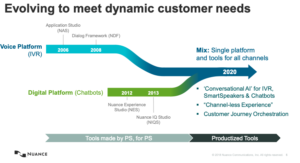 Nuance Communications took a giant step toward democratizing Enterprise Intelligent Assistant development with the introduction of Nuance Mix, a set of tools and APIs for do-it-yourself developers. Some readers may regard this as a reboot of Nuance Mix, a set of tools that the company offered as a beta in 2015 in anticipation of a flood of activity to popularize conversational user interfaces for services offered through the Internet of Things (IoT).
Nuance Communications took a giant step toward democratizing Enterprise Intelligent Assistant development with the introduction of Nuance Mix, a set of tools and APIs for do-it-yourself developers. Some readers may regard this as a reboot of Nuance Mix, a set of tools that the company offered as a beta in 2015 in anticipation of a flood of activity to popularize conversational user interfaces for services offered through the Internet of Things (IoT).
Well, things are different now. The new Nuance Mix responds to explosive growth in the number of in-house efforts to launch chatbots and virtual agents launched by teams of “citizen programmers” at the departmental level. Over the past four years, Opus Research has observed tens of thousands of stove-piped initiatives to bring conversational intelligent assistance to support customer care, Web-based commerce, mobile apps and, now, smart speakers . Today’s discrete teams risk duplicating efforts on incompatible systems or, worse, fail to take advantage of the treasure-trove of “prior art” embedded in the dialogue modules and user interface designs that resulted from efforts to speech-enable interactive voice response (IVR) systems. Nuance and its professional service personnel or partners pioneered “Say Anything” speech recognition in the early 2000s to support end-users’ ability to ask questions and carry out business using their own words.
Today with “digital” as the common denominator, Nuance Mix takes an open approach to service design, development, testing and optimization as well as deployment, reporting and ongoing management. “Open” is such a loaded word it deserves unpacking. It is designed with DIYers in mind, but uses tools and controls that are suitable for professional developers and data or speech scientists. They can use Nuance’s proprietary resources (E.g. Mix.nlu, Mix.asr, Mix.dialog) or integrate 3rd party offerings through APIs. Perhaps most important, it offers enterprises the ability to develop, deploy and manage both voice and digital intelligent assistants on a single platform, where it can benefit from machine learning, deep neural networking and admin and reporting systems.
In a nutshell, Mix enables non-technical personnel to define a consistent conversational experience across all channels and devices and migrate or import the resources that support existing chatbots, virtual assistants and speech-enabled IVRs. Based on decades of experience, conversational use cases exist for Financial Services, Travel, Entertainment, Gaming, Pharma and many others.
In the 2019 edition of Opus Research’s “Decision Makers’ Guide to Enterprise Intelligent Assistants (2019 Edition)”, we observed a lull in the growth in spending on chatbots and intelligent assistants. We attributed it to management pausing to take stock of many grassroots initiatives and proof-of-concepts in order to determine a way forward that can offer consistent and correct answers or recommendations at scale across both voice and digital channels. With Mix, Nuance is taking the right approach by opening up to non-professionals and providing a path to migrate existing, successful deployments into a single platform that is infused with Conversational AI to support both Healthcare and Enterprise customers.
Categories: Intelligent Assistants

 2025 Conversational AI Intelliview: Decision-Makers Guide to Self-Service & Enterprise Intelligent Assistants
2025 Conversational AI Intelliview: Decision-Makers Guide to Self-Service & Enterprise Intelligent Assistants  Talk to the Web: How NLWeb Opens Conversational Access to Site Content
Talk to the Web: How NLWeb Opens Conversational Access to Site Content  Battling ‘Botenfreude’: The Power of People and Policy
Battling ‘Botenfreude’: The Power of People and Policy  Voice AI Agents Redefine CX: Trends, ROI, and Strategies for 2025
Voice AI Agents Redefine CX: Trends, ROI, and Strategies for 2025